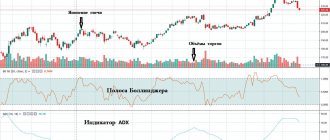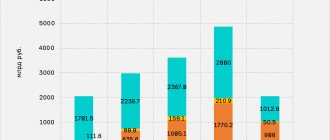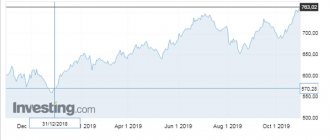Hello friends! One of my friends returned from the USA, where he worked for almost 5 years. When I asked what Americans were doing, he replied: “They sit at home, clipping coupons.” It is clear that this is the usual view of a migrant worker, but it cannot be denied: citizens of developed countries play very actively on the stock exchange. They are taught this from childhood.
Or maybe it's time for us to start too? The secondary securities market is exactly the place where you can make a fortune. Or lose it. But what is it and where is it located? This is what I propose to discuss.
What is the difference between markets
Relatively speaking, the primary market is the place where a security is traded for the first time. That's it in a nutshell.
In more detail: a company or government decides to issue a security. A long procedure of preparation and then placement begins. As a result, the security enters the primary market - the place where it is first traded.
The placement itself on the primary market comes in two forms:
- Private. This is the sale of securities to a limited number of previously known investors.
- Public. This is the placement of securities during their initial issue by selling to an unlimited number of investors.
Typically, the first buyers of securities are banks, pension funds, insurance companies, investment funds, mutual funds, and so on.
They can keep them to receive dividends or coupon income. But they can resell it to someone else.
This is where the secondary market begins, where further circulation of securities occurs. Here investors and traders buy and sell stocks, bonds and other securities. They make money, receive dividends, and sometimes lose.
In general, this is the place where the main investment movement takes place.
OTC market
You may sometimes hear the dealer market referred to as over-the-counter (OTC or RTS Board). Originally, the term meant a relatively unorganized system in which trading did not take place in a physical location, as I described above, but rather through dealer networks. The term most likely originated from the off-Wall Street trading that flourished during the great bull market of the 1920s, when stocks were traded "under the table" on local exchanges. In other words, the shares were not listed on the stock exchange, they were “unquoted.”
However, over time, the meaning of OTC began to change. Nasdaq was created in 1971 by the National Association of Securities Dealers (NASD) to provide liquidity to companies trading through dealer networks. At the time, there were few regulations in place for over-the-counter stock trading, and the NASD began to improve upon this. As the Nasdaq grew into a large exchange over time, the significance of over-the-counter trading became uncertain. Nowadays, the term "over-the-counter" usually refers to stocks that are not traded on a stock exchange such as Moscow Exchange, Nasdaq, NYSE, LSE, etc. This means that the stock is traded either on an over-the-counter bulletin board (OTCBB) or on an " Pink Sheets." In Russia, similar over-the-counter platforms are the RTS Board and the OTC platform of the Moscow Exchange. Neither of these systems is a stock exchange; in fact, they call themselves security price information providers. The OTCBB and pink sheet companies must comply with far fewer regulations than companies that trade shares on the stock exchange. Most securities that are traded this way are unprofitable companies or shares of very small companies. For these reasons, although the Nasdaq is still considered a dealer market and, technically, an over-the-counter market, today's Nasdaq is also recognized as and is a stock exchange, and therefore it would be incorrect to state that it trades unlisted securities.
$28.5 trillion This is the market capitalization of the New York Stock Exchange, the largest stock exchange in the world, at the end of 2021. Stock exchanges are considered part of the "secondary" market.
Who goes to the secondary market and why?
Here the main participants are speculators who seek to profit from the difference in stock prices:
- brokers acting on behalf of the client and at the expense of the client (commercial banks, investment companies, brokerage houses);
- dealers acting at their own discretion and risk;
- market makers are large players who sell and buy large volumes of securities.
But you and I, private investors, also “hang out” here. There is no other way for us to buy a stock or bond other than in the secondary market.
Everyone has a common goal - to make money. And this can be done in several ways: either through dividends or through rising share prices.
Third and fourth markets
You may also sometimes hear the terms "third" and "fourth" markets. This generally does not apply to private investors. These markets deal with transactions between broker-dealers and large institutions through over-the-counter electronic networks. The third market is over-the-counter (OTC) transactions between broker-dealers and large institutions. The fourth market consists of transactions that take place between large institutions. The main reason these transactions occur in the third and fourth markets is to avoid placing these large orders through the main exchange, which can greatly affect the price of the security. Since access to the third and fourth markets is limited, their activities have little impact on the average investor.
Structure of the secondary market, its types and participants
The secondary market itself is divided into 2 subtypes:
- Exchange market.
- Over-the-counter market.
The most developed is the exchange market. Large volumes are traded here. All this is organized and structured, and there is little risk of being deceived. But the price for this is strict formality, restrictions and increased responsibility of the parties.
The stock market is similar to an auction: here sellers and buyers compete for the best price.
The exchange market can be divided according to its structure:
- Government securities market;
- Stock market;;
- Market for municipal bonds or bonds of a federal subject;
- Markets for bills of exchange from different issuers;
- Derivatives markets (mainly futures).
Functions of the secondary securities market
- Creation of liquidity
. Financial assets are easily bought and sold due to the large number of buyers and sellers. - Pricing
. The secondary market quickly adapts to the current situation, reflecting any new information in the price of the instrument and ensuring a balance between supply and demand. - Safety
. Secondary markets face heavy government regulation as they are an important source of capital accumulation for corporations and investors. - Investment of funds
.
The secondary market has long been an excellent alternative to bank deposits .
How transactions are made
When you place an order to purchase something, the money from your account is debited to the seller's account. This is a responsible thing, so every exchange has:
- trade admission rules;
- rules for concluding and reconciling transactions;
- rules for registering transactions;
- procedure for executing transactions;
- rules limiting price manipulation;
- schedule for the provision of services by the trade organizer;
- list of securities admitted to trading.
To complete a transaction, you indicate the parameters: the date and time of its conclusion, the name of the securities, the state registration number of the security, the price of one security, the number of securities.
How to access
283 shares are traded on the Moscow Exchange. For comparison: in the US market there are more than 4,300 securities, in the European market - more than 4,000, in China - more than 3,000
Direct Market Access (DMA) is a technology for high-speed access to exchange platforms, in which an application is submitted directly to the exchange’s trading system, bypassing the broker’s trading system. Thanks to this, the time for delivering an application to the exchange and obtaining information about its status occurs almost instantly.
List of the best sites for stock investment analysis
For convenience, we have compiled a catalog of the best sites that help analyze companies to make decisions about buying or selling shares on stock exchanges. All this information in one form or another is provided free of charge, but there are not many truly high-quality, convenient and reliable resources.
In practice, an investor needs to analyze data in the following areas to make a decision on whether to make a transaction to buy or sell shares:
- Exchange quotes
- Company news and events
- Shareholders' meetings
- Company reporting
- Dividends and dates
- Forecasts and opinions of analysts
- Fundamental analysis of stocks
- Technical analysis
- Event calendars
Exchange quotes
Information about the current price of shares on stock exchanges, i.e. at what price can you buy or sell shares now?
The main criterion is the frequency of updating exchange data and access speed. Here the top three look like this:
Moscow Exchange quotes:
- BKS - quick access to Moscow Exchange quotes
- RBC - quick analysis of Moscow Exchange trading volumes
- Investing - quick analysis of key indicators
Foreign exchange quotes:
- Investing - American stock exchange quotes
- Investfunds - stock exchange quotes New-York, London, Hong Kong
- Trading view - US market quotes with deep filters
Company news and events
What news and events have happened to companies recently, the stronger the news, the more significant impact it has on the price of shares
The main criterion is reliability, legitimacy, efficiency
- Finam - company news from the largest broker in Russia
- Interfax is a corporate information disclosure center from the largest private news agency in Russia
- NSD - event feed of the Central Depository of Russia
Shareholders' meetings
At shareholder meetings, significant decisions are made that can significantly affect the company’s activities and the value of its shares.
- Smart-lab - shareholder meeting calendar
- Finam - upcoming events by company
- Interfax - search by decisions of company management bodies
Company reporting
Companies are required to disclose reports on their activities; they publish the main figures based on the results of work for the period
- Smart-lab - calendar of company reports
- Investfunds - search for reports by company
- MFD - search through corporate reports
Dividends and dates
Dividend dates are needed to determine the cutoff at which investors owning shares of the company will receive dividends for the declared period
- BKS - dividend calendar of companies traded on the stock exchange
- Smart-lab - upcoming cut-off dates (closing of shareholder registers)
- Income - filter by company dividends
Forecasts and opinions of analysts
They are needed as a kind of method of expert assessments, i.e. The more different expert opinions you read, the more perspective you will have on the company’s situation
- Smart-lab - stock forum for the trading community
- Investing - stock market analytics of the largest portal
- Finam - reviews and forecasts of the leading broker of the Russian Federation
Fundamental analysis of stocks
This is an analysis of the company from the point of view of multiples, i.e. common metrics by which you can compare companies of different sizes and industries to predict the future value of the company or its shares
- Smart-lab - analysis by sectors and industries of the economy
- Investing - filter stocks by indicators and multipliers
- Investfunds - graphical comparison of companies and their performance
Technical analysis
This is an analysis based on graphs, i.e. forecasting likely price changes based on historical patterns using charts. Trends and tendencies of future price changes are determined using the graphs
- Investing - summary technical analysis of companies
- Trading view - graphical technical analysis of companies
- Finam - buyers/sellers index
Event calendars
These are calendars that display the dates of important events for companies or for the market as a whole.
- Investing - calendar of macroeconomic events
- Finam - statistics by company and country
- Smart-lab - calendar of company reports
In general, the issue of stock analysis requires an integrated approach and before making a stock purchase/sale transaction, it is necessary to analyze the company from different angles and use the maximum number of tools. You are risking your money.
To make it more convenient for you, all links for stock analysis are collected in our catalog:
https://allfinancelinks.com/shares
Let's repeat the main thing
The article is complex, but this topic is important for investors. It's like driving a car - to drive your vehicle, you need to understand how it works. At least understand the basics.
So in short:
- The market is primary and secondary;
- In the primary market, shares are listed on the stock exchange for the first time, and some large investors buy them;
- You and I trade on the secondary;
- In turn, the secondary market is divided into exchange and over-the-counter;
- For security reasons, we, investors, are only interested in the stock market.











